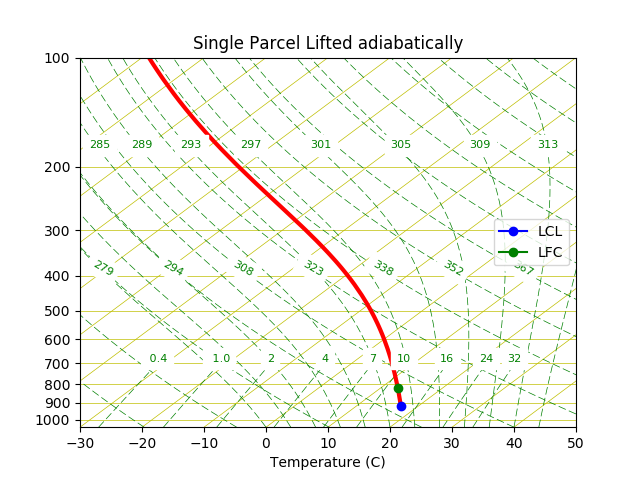Parcel Analysis¶
The SkewTplus package comes with the SkewTplus.thermodynamics module
that allows the following computations for a parcel:
SkewTplus.thermodynamics.parcelAnalysis()SkewTplus.thermodynamics.liftParcel()SkewTplus.thermodynamics.moistAscent()SkewTplus.thermodynamics.getLCL()
parcelAnalysis Function¶
The SkewTplus.thermodynamics.parcelAnalysis() function not only supports computations on 1D vertical soundings,
also it allows to do the analysis in a 3D domain (height,latitude or y ,longitude or x)
or 4D=(3D + time) ones (time,height,latitude or y ,longitude or x].
Below is simple example of how to perform a parcel analysis, print the results and then plot the parcel trajectory. For this example you need netCDF4 and Basemap packages installed:
from SkewTplus.skewT import figure
from SkewTplus.sounding import sounding
from SkewTplus.thermodynamics import parcelAnalysis, liftParcel
#Load the sounding data
mySounding = sounding("./exampleSounding.txt")
pressure, temperature, dewPointTemperature = mySounding.getCleanSounding()
# Perform a parcel analysis
# The full parcel analysis field is returned
# Most Unstable parcel : method=0
# Start looking for the most unstable parcel from the first level (initialLevel=0)
# Use at maximum 5 iterations in the bisection method to find the LCL
# Since the sounding temperature and pressure are expressed in Celsius and hPa
# we set the corresponding keywords
myParcelAnalysis = parcelAnalysis(pressure,
temperature,
dewPointTemperature,
hPa=True,
celsius=True,
fullFields=1,
method=1,
initialLevel=0,
tolerance=0.1,
maxIterations=20)
# Print the contents of the dictionary
for key,value in myParcelAnalysis.items():
if isinstance(value, float) :
print("%s = %.1f"%(key,value))
else:
print("%s = %s"%(key,str(value)))
#Plot the parcel trajectory in the SkewT diagram
# First we lift the parcel adiabatically
initialLevel = myParcelAnalysis['initialLevel']
parcelTemperature = liftParcel(temperature[initialLevel],
pressure,
myParcelAnalysis['pressureAtLCL'],
initialLevel=initialLevel,
hPa=True,
celsius=True)
# Create a Figure Manager
mySkewT_Figure = figure()
# Add an Skew-T axes to the Figure
mySkewT_Axes = mySkewT_Figure.add_subplot(111, projection='skewx')
# Plot the parcel temperature
mySkewT_Axes.plot(parcelTemperature, pressure, linewidth=3, color='r' )
# Add a marker for the LCL and the LFC
mySkewT_Axes.plot(myParcelAnalysis['temperatureAtLCL'],
myParcelAnalysis['pressureAtLCL'],
marker='o', color='b' , label='LCL')
mySkewT_Axes.plot(myParcelAnalysis['temperatureAtLFC'],
myParcelAnalysis['pressureAtLFC'],
marker='o', color='g' , label='LFC')
# Add a legend
mySkewT_Axes.legend(loc='center right')
mySkewT_Axes.set_title("Single Parcel Lifted adiabatically")
mySkewT_Figure.show_plot()

In the next chapter, a more intensive use of the parcelAnalysis function is used to compute CAPE for a 3D domain from a WRF output file: WRF Output CAPE plot